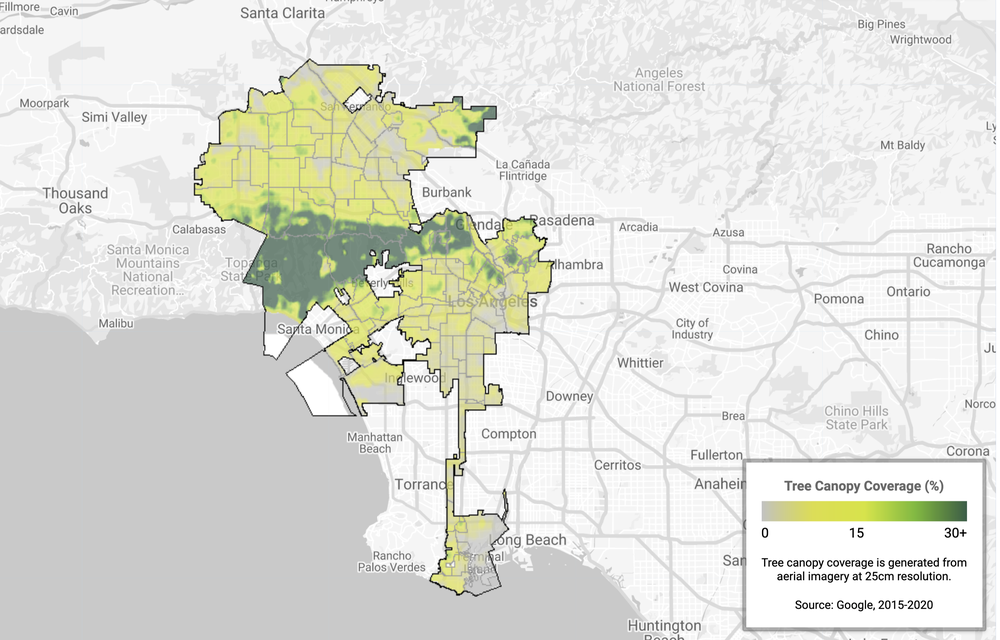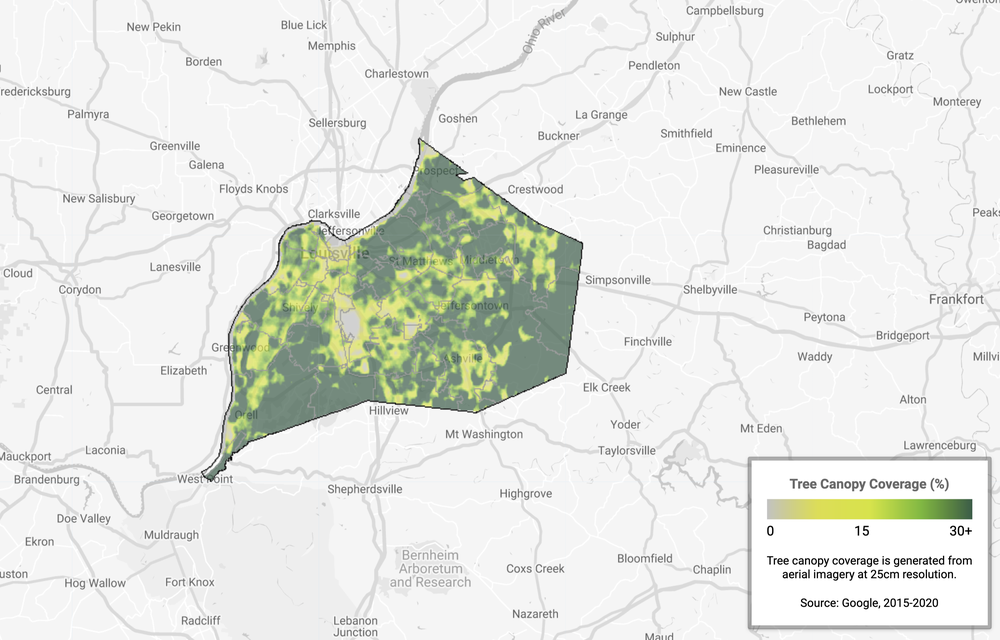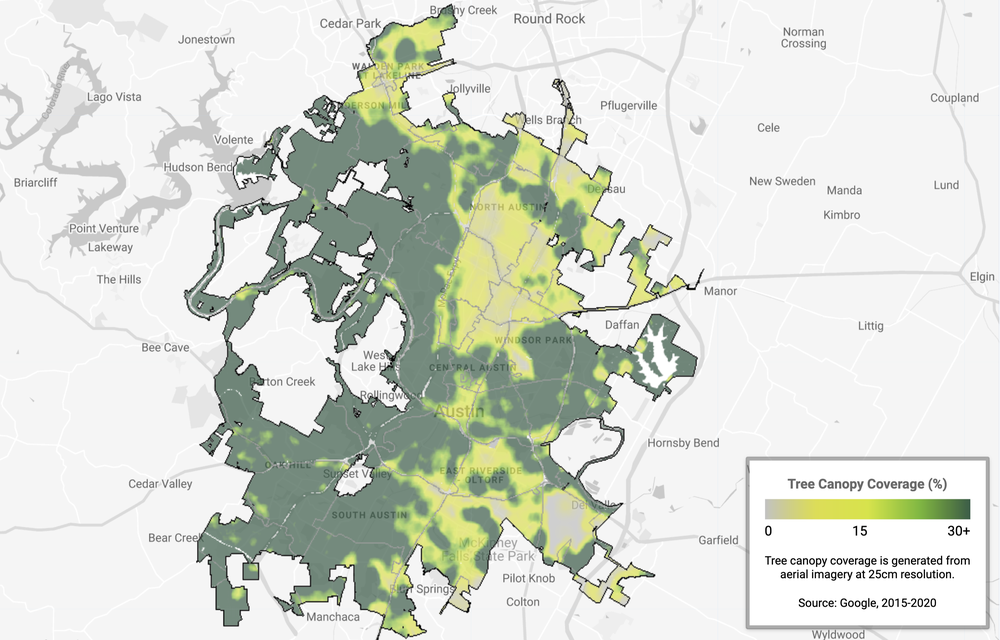How 5 cities plan to use Tree Canopy to fight climate change
Planting trees in cities helps provide shade, lower temperatures and contribute to cleaner air — all of which are huge benefits when it comes to adapting to the effects of climate change. That’s why we’re expanding our Environmental Insights Explorer Tree Canopy insights to more than 100 cities around the world next year, helping local governments fight climate change. We chatted with city officials in Los Angeles, Louisville, Chicago, Austin and Miami to learn more about how they plan to use Tree Canopy insights to build thriving, sustainable cities in 2021 and beyond.
Los Angeles

Tree canopy coverage in Los Angeles
Los Angeles was the first city to pilot Tree Canopy Insights. Since then it’s become an essential part of the city’s goal to increase tree canopy coverage by 50% by 2028 in areas of the city with the highest need. The city is working to plant 90,000 trees this year, and Tree Canopy Insights helps them prioritize which neighborhoods need tree shade the most.Rachel Malarich, Los Angeles’ City Forest Officer, and her team use Tree Canopy Insights alongside their inventory system to look at canopy acreage projections, current canopy cover and temperatures. The land use types within the tool allows them to consider the type of outreach needed and opportunities that exist in a given neighborhood. Most importantly, it helps Rachel and her team know which program initiatives are working and which aren’t.
“Tree Canopy Insights’ ability to give us timely feedback allows me to have data to make arguments for changes to the City's policies and procedures, as well as potentially see the impact of different outreach activities going forward.” - Rachel Malarich, Los Angeles City Forest Officer
Louisville

Tree canopy coverage in Louisville
Similar to other cities, Louisville officials found that monitoring tree coverage on their own was hugely expensive and time intensive. Sometimes it took years to get the accurate, up-to-date data needed to make decisions.
With Tree Canopy Insights, they’ve been able to glean actionable insights about tree cover faster. In just a few weeks, they’ve pinpointed that the west side of town was losing tree shade at an unprecedented rate and jump started a plan to plant more trees in the area.
“Planting trees is one of the simplest ways we can reduce the impacts and slow the progress of climate change on our city. With support from Google’s Tree Canopy Insights, Louisville can enhance its ongoing surveillance of hot spots and heat islands and understand the impact of land use and development patterns on tree canopy coverage.“ – Louisville Mayor Greg Fischer
Austin

Tree canopy coverage in Austin
Austin’s summers are hot with the heat regularly reaching over 90 degrees. Using Tree Canopy Insights, Marc Coudert, an environmental program manager for the city, noticed a troubling trend: ambient temperatures were higher in the eastern part of the city, known as the Eastern Crescent. With these insights, Marc and the City’s forestry team developed Austin’s Community Tree Priority Map and doubled down on planting trees in neighborhoods in the Eastern Crescent to make sure there was equitable tree canopy coverage across the city.
“At the city of Austin, we’re committed to making data-backed decisions that bring equity to all of our communities. Google’s Tree Canopy Insights empowers us to do exactly that.” - Austin Mayor Steve Adler
Chicago

Tree canopy coverage in Chicago
Chicago’s Department of Public Health understands that planting trees is an essential part of promoting health and racial equity. After all, a lack of trees can be associated with chronic diseases like asthma, heart disease and mental health conditions. With Tree Canopy Insights, the department discovered that their hottest neighborhoods are often also the most disadvantaged — making these communities extremely vulnerable. With the use of this tool, the City of Chicago is committed to focusing their tree planting efforts specifically on these high-risk areas.
"Trees not only provide our city with shade, green spaces and beauty, but they are also precious resources that produce clean air — making them key to shaping our sustainable future. Through this partnership with Google, our sustainability and public health teams will have access to real-time insights on our tree coverage that will inform how we develop and execute our equitable approach to building a better Chicago landscape. I look forward to seeing how this technology uses our city's natural resources to benefit all of our residents." - Chicago Mayor Lori E. Lightfoot.
Miami

Tree canopy coverage in Miami
Miami gets over 60 inches of rain per year, leading to potentially devastating effects from flooding and infrastructure damage. To address this, the city recently launched their Stormwater Master Plan. The multi-year initiative has already resulted in over 4,000 trees planted, translating to an additional 400,000 gallons of water absorption capacity per day. Moving forward, the city plans to use Tree Canopy Insights to evolve and improve this plan.
“Google’s Tree Canopy Insights is going to help us build on the progress of our Stormwater Master Plan in smarter, more effective ways. We believe that every city needs to be a “tech city,” and leveraging Google’s AI capabilities to improve every Miamians quality of life is exactly what I mean by that.” – Miami Mayor Francis Suarez
If you’re part of a local government and think Tree Canopy Insights could help your community, please get in touch with our team by filling out this form.by Ruth AlcantaraGoogle AI via The Keyword
Comments
Post a Comment